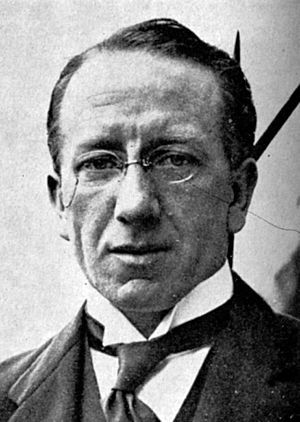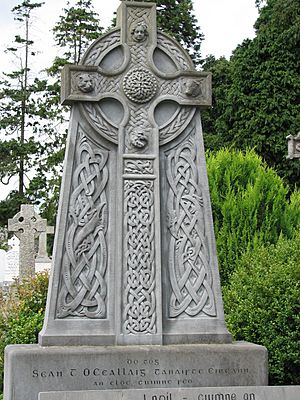Seán T. O'Kelly facts for kids
Quick facts for kids
Seán T. O'Kelly
|
|
|---|---|
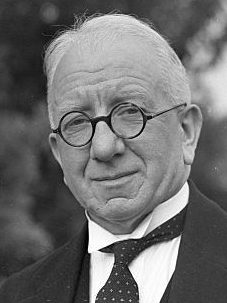
O'Kelly in 1949
|
|
| President of Ireland | |
| In office 25 June 1945 – 24 June 1959 |
|
| Taoiseach | |
| Preceded by | Douglas Hyde |
| Succeeded by | Éamon de Valera |
| Tánaiste | |
| In office 29 December 1937 – 14 June 1945 |
|
| Taoiseach | Éamon de Valera |
| Preceded by | Himself as Vice President of the Executive Council |
| Succeeded by | Seán Lemass |
| Minister for Finance | |
| In office 16 September 1939 – 14 June 1945 |
|
| Taoiseach | Éamon de Valera |
| Preceded by | Seán MacEntee |
| Succeeded by | Frank Aiken |
| Minister for Local Government and Public Health | |
| In office 9 March 1932 – 8 September 1939 |
|
| Taoiseach | Éamon de Valera |
| Preceded by | Richard Mulcahy |
| Succeeded by | P. J. Ruttledge |
| Vice-President of the Executive Council | |
| In office 9 March 1932 – 29 December 1937 |
|
| President | Éamon de Valera |
| Preceded by | Ernest Blythe |
| Succeeded by | Himself as Tánaiste |
| Ceann Comhairle of Dáil Éireann | |
| In office 22 January 1919 – 16 August 1921 |
|
| Deputy |
|
| Preceded by | Count Plunkett |
| Succeeded by | Eoin MacNeill |
| Teachta Dála | |
| In office July 1937 – 25 June 1945 |
|
| Constituency | Dublin North-West |
| In office August 1923 – July 1937 |
|
| Constituency | Dublin North |
| In office May 1921 – August 1923 |
|
| Constituency | Dublin Mid |
| In office December 1918 – May 1921 |
|
| Constituency | Dublin College Green |
| Personal details | |
| Born |
John Thomas O'Kelly
25 June 1882 Dublin, Ireland |
| Died | 23 November 1966 (aged 84) Blackrock, Dublin, Ireland |
| Resting place | Glasnevin Cemetery, Dublin, Ireland |
| Political party | Fianna Fáil |
| Spouses |
|
| Alma mater | University College Dublin |
| Signature | |
| Military service | |
| Rank | Staff captain |
| Unit | Irish Volunteers |
| Battles/wars | Easter Rising |
Seán T. O'Kelly (born John T. O'Kelly) was a very important Irish politician. He served as the second President of Ireland from 1945 to 1959. Before becoming President, he held many other key roles in the Irish government. These included deputy prime minister (called Tánaiste at the time) and several ministerial positions. He was also a Teachta Dála (TD), which is a member of the Irish Parliament, for many years. O'Kelly played a big part in Ireland's journey to becoming an independent republic.
Contents
Seán T. O'Kelly: Ireland's Second President
Early Life and Education
Seán T. O'Kelly was born in Dublin, Ireland, on June 25, 1882. His birth name was John Thomas Kelly. He was the oldest son of Samuel O'Kelly, a shoemaker. He had a twin sister, Anna Maria, and many other brothers and sisters. Some of his brothers went to a special school run by Patrick Pearse, a famous Irish leader. O'Kelly went to several schools in Dublin, including those run by the Christian Brothers. After school, he worked at the National Library of Ireland. He became very interested in Irish culture and joined the Gaelic League in 1902. This group worked to promote the Irish language and traditions. He also managed a newspaper called An Claidheamh Soluis, which was important for Irish independence movements.
Joining the Fight for Irish Independence
O'Kelly quickly became involved with Arthur Griffith, a key figure in Irish nationalism. He joined the Irish Republican Brotherhood in 1901, a secret group working for Irish independence. In 1905, he helped found Sinn Féin, a political party that aimed for Ireland to be independent. He served as a secretary for Sinn Féin for many years. He was also elected to the Dublin Corporation (Dublin's city council) in 1906. There, he worked to improve living conditions in Dublin's poorer areas. O'Kelly was one of the first members of the Irish Volunteers in 1913. This group was formed to protect Irish rights. In 1915, he traveled to New York City to share plans for an uprising in Dublin with Irish-American groups.
The Easter Rising of 1916
During the Easter Rising in 1916, O'Kelly was actively involved. This was a major rebellion against British rule in Ireland. He was in the GPO, a main center of the Rising. He was even asked to help set up a temporary government for the new Irish Republic. After the Rising, O'Kelly was arrested and imprisoned. He later managed to escape from a prison in England and returned to Ireland. The Rising led to a big change in Irish politics. Sinn Féin gained a lot of support and won many seats in the 1918 general election.
Forming the First Irish Parliament
In the 1918 Irish general election, O'Kelly was elected as a MP for Dublin College Green. However, instead of going to the British Parliament in London, O'Kelly and other Sinn Féin MPs created their own Irish Parliament in Dublin. They called it Dáil Éireann. O'Kelly became the first Ceann Comhairle (chairperson) of this new Dáil. He also helped publish the Democratic Programme, a document outlining the goals for an independent Ireland. He traveled to Paris after World War I to ask for international recognition for the Irish Republic. He also visited Italy and met with Pope Benedict XV to explain the situation in Ireland. He even met with Benito Mussolini, who would later become Italy's leader.
A Key Figure in Irish Government
Working with Éamon de Valera
O'Kelly was a close friend and colleague of Éamon de Valera, another very important Irish leader. De Valera served as the head of the Irish government during these years. O'Kelly, like de Valera, did not support the Anglo-Irish Treaty signed in 1921. This treaty created the Irish Free State but kept a link to Britain. When the Irish Civil War broke out, O'Kelly was imprisoned until 1923. After his release, he spent two years in the United States. There, he worked to raise money to help those who opposed the treaty and the many prisoners held by the new Irish Free State government.
Helping to Found Fianna Fáil
In 1926, Éamon de Valera left Sinn Féin to start a new political party called Fianna Fáil. O'Kelly returned to Ireland and became a vice-president of this new party. He helped build support for Fianna Fáil, which quickly became a major force in Irish politics. When Fianna Fáil won the general election in 1932, de Valera became the head of the government. O'Kelly was appointed as his deputy, holding the title of Vice-President of the Executive Council. He also became the Minister for Local Government. During this time, O'Kelly was involved in some disagreements with the Governor-General of the Irish Free State, James McNeill. These events caused a stir and were widely discussed.
Serving as Tánaiste and Finance Minister
In 1937, Ireland adopted a new constitution. O'Kelly continued to be de Valera's second-in-command, now with the title of Tánaiste. There was talk in 1938 that O'Kelly might become the first President of Ireland, a new role created by the constitution. However, the position eventually went to Douglas Hyde. Hyde was a Protestant and a great supporter of the Irish language, and his election showed appreciation for his work in Irish society. O'Kelly was appointed Minister for Finance in 1941. He helped pass an important law in 1942 that created the Central Bank of Ireland. This bank was designed to be controlled by the Irish Parliament.
Leading Ireland as President
First Term as President (1945-1952)
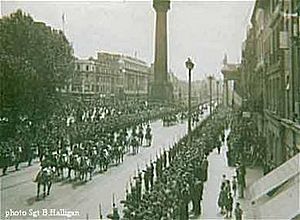
O'Kelly became the Fianna Fáil candidate for President of Ireland in 1945. He won the election, becoming the second President of Ireland. One time, during a visit to the Vatican City, O'Kelly accidentally shared some private opinions of Pope Pius XII with the media. This was a mistake in diplomatic manners. A very important event during his presidency was the signing of the Republic of Ireland Act 1948. This law officially made Ireland a republic, completely independent from the British Commonwealth, on April 18, 1949. This meant O'Kelly was the first Irish President to be fully recognized internationally as a head of state.
Historic Visit to the United States
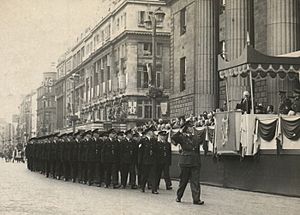
In March 1959, President O'Kelly made history by becoming the first President of Ireland to visit the United States of America. He was a guest of US President Dwight Eisenhower. He was invited to speak to both houses of the U.S. Congress. This visit was very important because it showed that the United States recognized Ireland as a fully independent republic with its own head of state. Historians say this visit helped improve trust between Ireland and the United States. Both countries had been neutral at the start of World War II, but the U.S. joined the war later. Ireland remained neutral, which had caused some tension. The invitation to President O'Kelly showed that any past disagreements were resolved.
Second Term and Retirement (1952-1959)
O'Kelly was re-elected without opposition in 1952. During his second term, he traveled to many countries in Europe and even spoke to the United States Congress in 1959. He finished his second term in 1959 and was succeeded by his old friend, Éamon de Valera. As President, O'Kelly had the power to send certain laws to the Supreme Court of Ireland for review, but he never did. He also dissolved the Dáil (the Irish Parliament) four times when advised by the Taoiseach (Prime Minister).
Personal Life and Legacy
Faith and Public Image
O'Kelly was known for being a very religious Catholic. His first state visit after Ireland became a republic in 1949 was to the Vatican City to meet Pope Pius XII. He was also a member of the Knights of Saint Columbanus, a Catholic organization. People often commented on O'Kelly's personal habits, but he always maintained a dignified public image. He was known for being a short man with a good sense of humor. Once, at a football match, someone in the crowd joked about his height, saying, "Cut the grass, we can't see the President!" When he retired in 1959, a newspaper called The Irish Times described him as a "model President." He was seen as a genuine and honest leader, even if he sometimes spoke without thinking. Seán T. O'Kelly passed away on November 23, 1966, at the age of 84. He is buried in Glasnevin Cemetery in Dublin.
Family and Marriages
In 1918, O'Kelly married Mary Kate Ryan, who was known as Kit. She was a professor of modern languages at the National University. They were married until her death in 1934. They did not have any children. In 1936, O'Kelly married Kit's younger sister, Phyllis Ryan, after getting special permission from the Church. Phyllis was a chemist. She sadly lost her first child and was unable to have more. Kit and Phyllis had a brother named James Ryan, who also became a Fianna Fáil Minister. Another sister, Josephine Ryan, was married to General Richard Mulcahy, a leader of the Fine Gael party.
See also
 In Spanish: Seán T. O'Kelly para niños
In Spanish: Seán T. O'Kelly para niños
- List of people on stamps of Ireland


